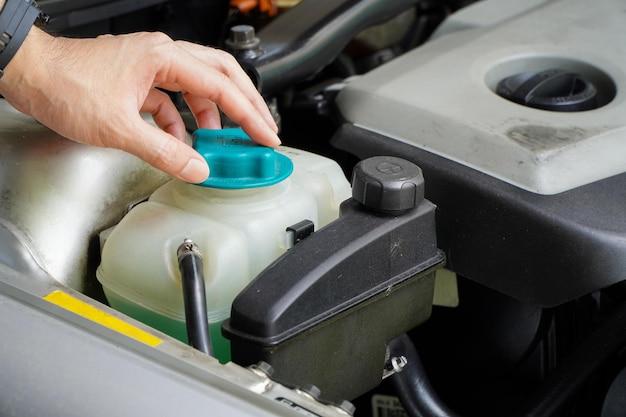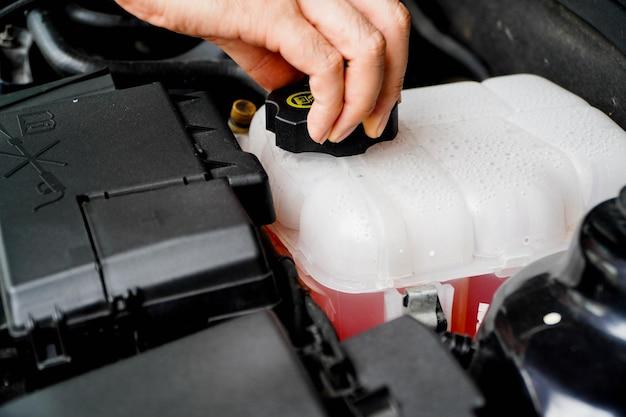As a car owner, it’s crucial to understand how your car’s cooling system works and the importance of maintaining adequate coolant levels. One common question that often arises is, “How long after adding coolant can I drive?” In this blog post, we will address this question and provide you with valuable information to ensure the optimal functioning of your car’s cooling system.
You’ll find answers to important queries such as why your car may still overheat even after adding coolant, how to know if your car needs coolant, and the potential damage caused by running a hot engine. We’ll also discuss the impact of overfilling coolant, the time it takes for coolant to work, and what to do when your coolant is low but there are no visible leaks. Additionally, we’ll explore how long you can safely drive with low coolant levels and the recommended period to let your car run after adding coolant to prevent overheating.
Join us as we delve into these essential topics and provide you with the knowledge you need to keep your car’s cooling system running smoothly. So, read on to find out everything you need to know about driving safely after adding coolant to your car.
Stay tuned for more updates on car maintenance tips and tricks throughout 2023.
How Long After Adding Coolant Can I Drive
If you’ve recently added coolant to your car’s engine, you’re probably wondering when it’s safe to hit the road again. Let’s dive into this important question and explore the factors that affect the duration of the waiting time.
The Importance of Coolant in Your Car’s Engine
Before we discuss how long you should wait after adding coolant, let’s quickly review the importance of this vital fluid. Coolant, also known as antifreeze, plays a crucial role in regulating the temperature of your car’s engine. It prevents overheating during hot summer days and freezing during icy winters. Without proper levels of coolant, your engine could be at risk of serious damage.
Cooling System Pressurization and Circulation
To understand the waiting time after adding coolant, it’s essential to grasp how the cooling system works. When you add coolant, it needs to circulate effectively throughout the engine to regulate its temperature. This circulation occurs due to the pressurization created by the water pump. So, if the coolant hasn’t fully circulated, driving too soon could lead to uneven cooling, potentially damaging your engine.
Factors Affecting the Waiting Time
Several factors come into play when determining how long you should wait after adding coolant. One crucial factor is the type of coolant you’re using. Different coolants have varying mixing ratios, so be sure to consult your car’s manual or a trusted mechanic for the recommended waiting time.
Another factor to consider is the outside temperature. In colder weather, coolant takes longer to circulate and warm up. It’s wise to give it more time before hitting the road. If you’re in a rush, consider idling the engine for a few extra minutes to ensure proper circulation and heating.
Recommended Waiting Time
While it’s always best to rely on your vehicle’s manual or professional advice, a general guideline is to wait around 10-15 minutes after adding coolant before driving. This waiting period allows the coolant to fully circulate and reach optimal temperature levels. Remember, it’s better to be safe than sorry when it comes to taking care of your car’s engine.
In conclusion, after adding coolant to your car’s engine, it’s crucial to give it sufficient time to circulate and regulate temperature before hitting the road. Waiting for around 10-15 minutes is typically recommended, but always refer to your vehicle’s manual or seek professional advice for the most accurate waiting time. By prioritizing the health of your engine, you’ll ensure smooth and worry-free driving experiences. So, next time you’re adding coolant, remember to channel your inner patience and wait for the green light!
FAQ: How Long After Adding Coolant Can I Drive
Can I just add coolant to my car without flushing?
Adding coolant to your car without flushing is not recommended. Flushing the coolant system helps to remove any built-up debris, rust, or contaminants that may hinder the coolant’s effectiveness. It ensures optimal performance and helps prevent issues in the future.
Why is my car still overheating after adding coolant?
If your car continues to overheat even after adding coolant, there could be an underlying problem. It’s possible that there is a leak in the system, a malfunctioning radiator, a faulty thermostat, or a damaged water pump. It’s best to have your car inspected by a qualified mechanic to identify and resolve the root cause of the overheating.
How do I know if my car needs coolant?
There are a few signs that indicate your car may need coolant. If you notice your engine temperature gauge rising, steam coming from under the hood, a sweet smell in the cabin, or if the low coolant warning light illuminates on your dashboard, it’s time to check your coolant levels.
How long can a car run hot before damage?
Running a car hot for an extended period can cause severe damage to the engine and other components. If your car is consistently running hot, it’s crucial to address the issue promptly to avoid costly repairs. Continuing to drive a hot car can lead to warped cylinder heads, blown head gaskets, and even a complete engine failure.
Can overfilling coolant cause damage?
Yes, overfilling your coolant can cause damage. The cooling system in your car operates under a specific pressure range. Overfilling the coolant can lead to increased pressure, which can cause hoses to burst or the radiator to crack. Always follow the manufacturer’s guidelines and fill the coolant to the recommended level.
How long does it take for coolant to work?
After adding coolant to your car, it typically takes a few minutes for the coolant to circulate throughout the system and start working. However, if your car was low on coolant due to a leak or other issues, it’s essential to address the root cause to ensure proper cooling system functionality.
Why is my coolant low but no leaks?
If your coolant level is consistently low but there are no visible leaks, it could indicate an internal leak. There may be an issue with the head gasket, intake manifold gasket, or even a cracked engine block. It’s crucial to have your car inspected by a professional to diagnose and rectify the problem.
How long does it take coolant to warm up?
The time it takes for coolant to warm up can vary depending on various factors, such as the outside temperature and the efficiency of your car’s cooling system. On average, it takes about 5 to 15 minutes of driving for the coolant to reach its optimal operating temperature.
How long can you drive with low coolant?
It’s not recommended to drive with low coolant levels. The cooling system plays a vital role in maintaining an appropriate engine temperature, and inadequate coolant can lead to overheating, potential engine damage, and costly repairs. If your coolant level is low, it’s best to address the issue before driving.
How long should you let the car run after adding coolant to ensure it is no longer overheating?
After adding coolant to your car, it’s a good practice to let it run for about 10 to 15 minutes while monitoring the engine temperature. This allows the coolant to circulate and dissipate any remaining air pockets. Keep an eye on the temperature gauge to ensure it stays within the normal range.
How long should I let my car heat up?
In colder weather conditions, it’s recommended to let your car heat up for a few minutes before driving. This allows the engine oil to warm up, ensuring proper lubrication and reducing wear on engine components. However, it’s important not to let your car idle excessively as it can waste fuel and contribute to pollution.
How fast should my car heat up?
The time it takes for a car to heat up can vary depending on numerous factors, including the outside temperature, engine size, and driving conditions. In general, it takes about 5 to 15 minutes of driving for the engine to reach its optimal operating temperature.
Can I drive with an empty coolant reservoir?
No, it is not safe to drive with an empty coolant reservoir. The coolant reservoir acts as a reserve supply for the cooling system. If the reservoir is empty, it means that the coolant level in the system is insufficient. This can lead to overheating, potential engine damage, and the need for costly repairs.
How many gallons of coolant does a car need?
The amount of coolant required varies depending on the size of your car’s engine and cooling system. On average, most cars require around 1 to 2 gallons of coolant. However, it’s always best to consult your car’s owner manual or contact a professional for specific recommendations.
Do you need to top up coolant?
Yes, it’s essential to regularly check and top up your car’s coolant levels. Coolant plays a crucial role in maintaining proper engine temperature and preventing overheating. Regular monitoring and maintenance of the coolant levels can help ensure the longevity and optimal performance of your vehicle.
How cool does the engine have to be to add coolant?
Before adding coolant, it’s important to ensure that the engine is cool to the touch. Opening the radiator cap or coolant reservoir cap while the engine is still hot can lead to steam burns and other injuries. Give your engine enough time to cool down before attempting to add coolant.
What should I do after adding coolant?
After adding coolant to your car, it’s important to secure the radiator cap or coolant reservoir cap tightly. Check for any signs of leaks around the system. Start your car and let it run for a few minutes to allow the coolant to circulate. Monitor the engine temperature gauge to ensure it stays within the normal range.
Can I drive after adding coolant?
Yes, you can typically drive your car after adding coolant, provided there are no pre-existing issues that may cause overheating. However, it’s crucial to monitor the engine temperature closely and ensure it stays within the normal range. If you notice any signs of overheating or other problems, it’s best to pull over and have your vehicle inspected by a professional.
Does new coolant make the car run better?
Using fresh coolant can help maintain the cooling system’s efficiency and prevent overheating. Over time, coolant can break down, lose its effectiveness, and become contaminated. By replacing the old coolant with new coolant, you can ensure optimal performance and extend the lifespan of your car’s cooling system.

